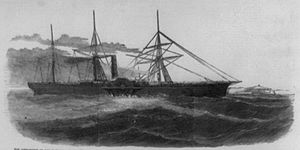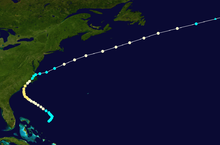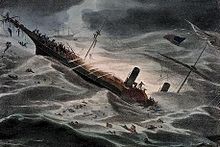- SS Central America
-

Career 
Name: SS Central America Operator: United States Mail Steamship Company Fate: Sunk 1857 General characteristics Tonnage: 2,141 tons Length: 278 ft (85 m) Beam: 40 ft (12 m) SS Central America, sometimes called the Ship of Gold, was a 280-foot (85 m) sidewheel steamer that operated between Central America and the eastern coast of the United States during the 1850s. She was originally named the SS George Law, after Mr. George Law of New York. The ship sank in a hurricane in September 1857, along with 400 passengers and crew and 30,000 pounds of gold, contributing to the Panic of 1857.
Contents
Sinking
On 3 September 1857, 477 passengers and 101 crew left the Panamanian port of Colón, sailing for New York City under the command of William Lewis Herndon. The ship was heavily laden with 10 tons of gold prospected during the California Gold Rush. After a stop in Havana, the ship continued north.
On 9 September, the ship was caught up in a Category 2 hurricane while off the coast of the Carolinas. By 11 September, the 105 mph (165 km/h) winds and heavy surf had shredded her sails, she was taking on water, and her boiler was threatening to go out. A leak in one of the seals to the paddle wheels sealed her fate, and, at noon that day, her boiler could no longer maintain fire. Steam pressure dropped, shutting down both the pumps keeping the water at bay and the paddle wheels that kept her pointed into the wind as the ship settled by the stern. The passengers and crew flew the ship's flag upside down (a universal sign of distress) to try to signal a passing ship. No one came.
A bucket brigade was formed and her passengers and crew spent the night fighting a losing battle against the rising water. During the calm of the hurricane, attempts were made to get the boiler running again, but these all failed. The second half of the storm then struck. The ship was now on the verge of foundering. Without power, the ship was carried along with the storm, so the strong winds would not abate. The next morning, two ships were spotted, including the brig Marine. 153 people, primarily women and children, managed to make their way over in lifeboats. However, the ship remained in an area of intense winds and heavy seas that pulled the ship and most of her company away from rescue and eventually took the ship and many of the roughly 425 people still on board to the bottom at around 8 pm that night. A Norwegian bark, Ellen, rescued an additional fifty from the waters.[1] Another three were picked up over a week later in a lifeboat.
Effects of the sinking
At the time of her sinking, the Central America carried gold then valued at approximately $2 million USD. The loss shook public confidence in the economy, and contributed to the Panic of 1857.
Commander William Lewis Herndon, a distinguished officer who had served during the Mexican-American War and explored the Amazon Valley, was captain of the Central America. Commander Herndon went down with his ship. Two US Navy ships were later named USS Herndon in his honor, as was the town of Herndon, Virginia.
Several books were written about this historic ship. One book is America's Lost Treasure, a pictorial chronicle of the sinking and recovery. Gary Kinder's Ship of Gold in the Deep Blue Sea is an account of the recovery efforts.
Search and discovery
The ship was located by the use of Bayesian search theory and a remotely operated vehicle (ROV) operated by the Columbus-America Discovery Group of Ohio, that was sent down on 11 September 1987. Significant amounts of gold and artifacts were recovered and brought to the surface by another ROV built specifically for the recovery. Tommy Thompson led the group. Thirty-nine insurance companies filed suit, claiming that because they paid damages for the lost gold, they had the right to it. The team that found it argued that the gold had been abandoned. After a legal battle, 92% of the gold was awarded to the discovery team in 1996.
The total value of the recovered gold was estimated at $100-150 million. A recovered gold ingot weighing 80 pounds sold for a record $8 million USD and was recognized as the most valuable piece of currency in the world at that time.[2]
See also
Further reading
- Kinder, Gary. (1998). Ship of Gold in the Deep Blue Sea. Atlantic Monthly Press. ISBN 0-87113-717-8
- Thompson, Tommy. (2000). America's Lost Treasure. Atlantic Monthly Press. ISBN 0-87113-732-1
- Klare, Norman. (1991 and 2005). The Final Voyage of the Central America, 1857: The Saga of a Gold Rush Steamship. ISBN 0-87062-210-2 and ISBN 0-9764403-0-X
- Stone, Lawrence D. Search for the SS Central America: Mathematical Treasure Hunting. Technical Report, Metron Inc. Reston, Virginia.
Footnotes
External links
- Web site about the ship
- America's Lost Treasure: The Wreck of the SS Central America
- The Final Voyage of the SS Central America - an exhaustive historical account by historian Normand E. Klare
- Central America Engulfed in Ocean
- Wreck of the Central America
- "The Central America: Further of the Disaster", New York Times, 23 Sept 1857
-
- – "Detailed and Very Interesting Statement of Captain Badger" and "Protest of the Surviving Officers"
-
- NOAA list of deadliest hurricanes
Categories:- Victorian era merchant ships of the United States
- Shipwrecks in the Atlantic Ocean
- Maritime incidents in 1857
- Shipwrecks of the Carolina coast
- Treasure from shipwrecks
- California Gold Rush
- Paddle steamers
- Steamships
- 1853 ships
- 1850s meteorology
Wikimedia Foundation. 2010.


